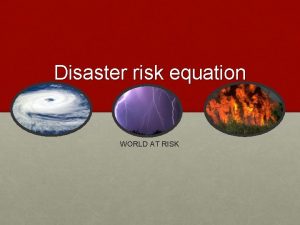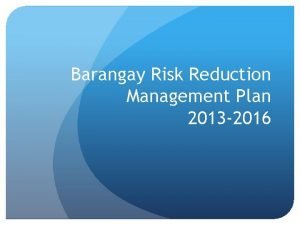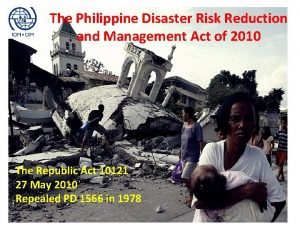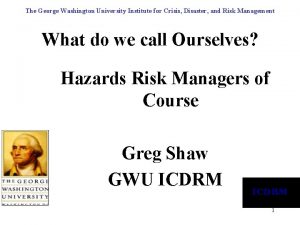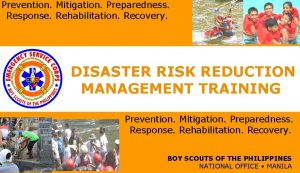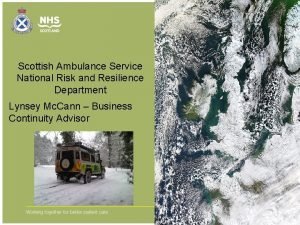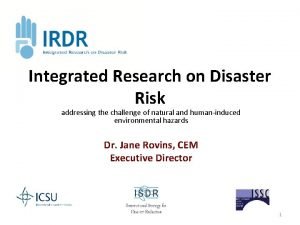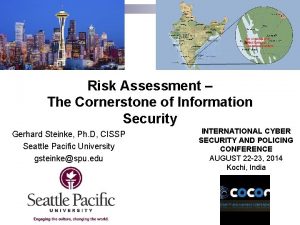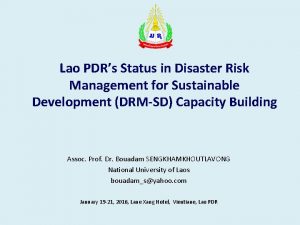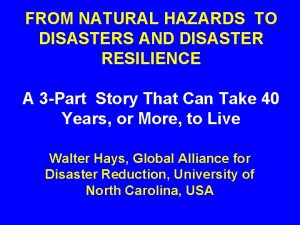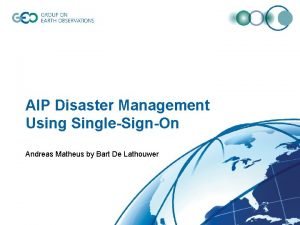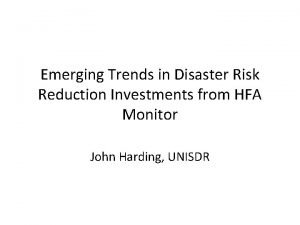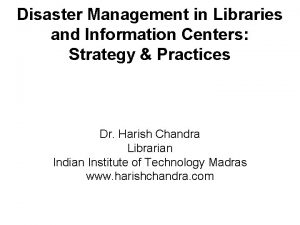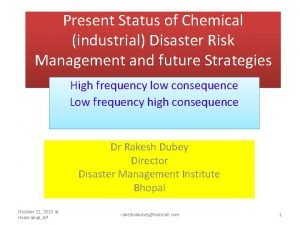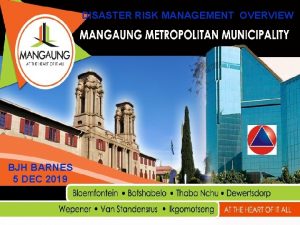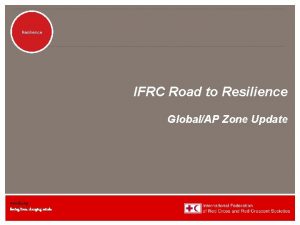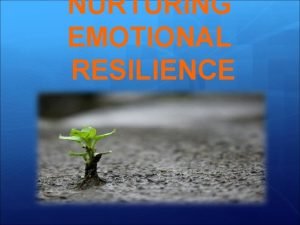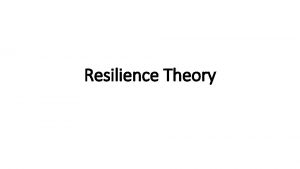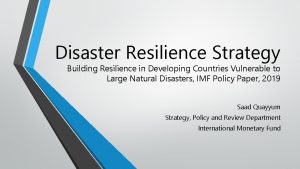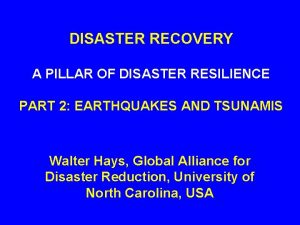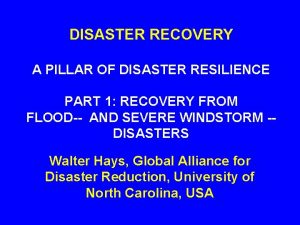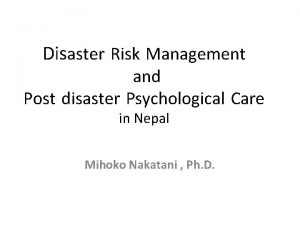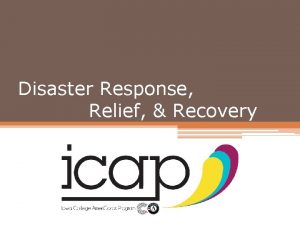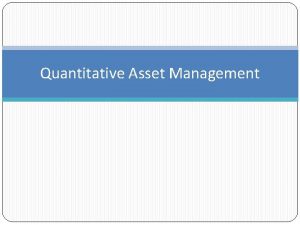FROM RISK MANAGEMENT TO QUANTITATIVE DISASTER RESILIENCE A


























- Slides: 26

FROM RISK MANAGEMENT TO QUANTITATIVE DISASTER RESILIENCE A PARADIGM SHIFT Slobodan P. Simonović FCAE, FCSCE, FASCE, FIWRA Department of Civil and Environmental Engineering Western University

2| CONCLUSIONS • There are practical links between adaptation to global change practical links and sustainable development leading to: • • Systems approach to quantification of resilience allows: Systems approach • • re-enforcing resilience as a new development paradigm resilience capturing temporal and spatial dynamics of disaster management better understanding of factors contributing to resilience more systematic assessment of various measures to increase resilience Understanding of local context of vulnerability and exposure is local context fundamental for increasing resilience

3| PRESENTATION OUTLINE • • Introductory remarks From risk to resilience • • Limitations of risk management Definition of resilience Quantification of resilience Implementation of quantitative resilience measure • • Examples • • Systems approach (simulation, time and space) Climate change caused urban flooding Multi purpose reservoir operation Urban infrastructure network system Conclusions

4| INTRODUCTION Research support Principal investigator • Systems Engineering Approach to the Reliability of Complex Hydropower Infrastructure • NSERC CRD with BC Hydro: 2014 -2018 $673, 334 • Linking Hazard, Exposure and Risk Across Multiple Hazards • NSERC CRD with Chaucer Synd. : 2015 -2019 $1, 375, 600 Co-investigator • Coastal Cities at Risk (CCa. R): Building Adaptive Capacity for Managing Climate Change in Coastal Megacities • • IDRC - International Research Initiative on adaptation to Climate Change: 2011 – 2016 $2, 500, 000 Advanced Disaster, Emergency and Rapid Response Simulation • NSERC CREATE: 2015 -2021 $1, 650, 00

5| INTRODUCTION Global change • Global change • • • Infrastructure systems (hard) • • • Population growth Land use change Climate change Complexity and uncertainty Water Energy Transport Communications Infrastructure (soft) • • • Institutional Social Cultural

6| INTRODUCTION Shifts in disaster management • There is a shift in the approach to effective disaster management: shift • • Focus on resilience provides: • • from focusing on disaster risk reduction strategies to focusing on building disaster resilience through effective adaptation actions; from considering static characteristics of vulnerable types of populations to considering the dynamic attributes of resilient communities; and beginning to recognize the importance of both the spatial and temporal dynamics of resilience. a positive approach to disaster management; for consideration of opportunities that arise in the wake of a opportunities disaster; and an opportunity to grow and improve a situation to reduce future potential impacts. Systems analysis based approach: • • simulation (short and long term); and simulation systematic assessment of various options to increase resilience.

RISK TO RESILIENCE 7| Need for paradigm change • The broad definition Risk = Hazard x Consequence • The combination of the probability of an event and its negative consequences.

8| RISK TO RESILIENCE Need for paradigm change • Risk management framework • • Resilience framework • • Static (in time and space) Difficulties in assessing probability of extreme events Difficult integration of physical, social, economic and ecological concerns Dynamic (in time and space) Not only assessment of direct and indirect losses – broader framework

9| • RESILIENCE Definitions Initial ecology-based (Holling, 2001) • • Hazard – based • • • …the ability of a system to withstand stresses of ‘environmental loading’… …capacity for collective action in response to extreme events… …the capacity of a system, community, or society potentially exposed to hazards to adapt, by resisting or changing, in order to reach and maintain an acceptable level of functioning and structure… …the capacity to absorb shocks while maintaining function… …the capacity to adapt existing resources and skills to new situations and operating conditions… Used in this research • • …the ability of an infrastructure system and its component parts to anticipate, absorb, accommodate or recover from the effects of a system disruption in a timely and efficient manner, including through ensuring the preservation, restoration or improvement of its essential basic structures and functions… functions System performance and system adaptive capacity

10| RESILIENCE Quantification

RESILIENCE 11| Implementation – temporal dynamics

RESILIENCE 12| Implementation – spatial dynamics SD Temporal dynamics GIS dynamic data exchange Spatial dynamics

RESILIENCE 13| Implementation – temporal and spatial dynamics System disruption!

14| EXAMPLE 1 Climate change caused urban flooding • Vancouver • • Sea level rise Riverine flooding Set of climate scenarios Impacts (i) • • Physical Social Health Economic

EXAMPLE 1 15| Climate change caused urban flooding

16|EXAMPLE 2 Multi purpose reservoir operation

17|EXAMPLE 2 Multi purpose reservoir operation • Turbine failure • • • Single event Temporal variability No spatial variability • Water scarcity • • Water supply Temporal and spatial variability

18|EXAMPLE 3 Urban infrastructure network system • Urban infrastructure network • Four layers: • • • Nodes and edges (two states) Intra and interconnections • • • Streets Water supply Energy supply Information Node node Node edge Node path Node cluster Single and multiple disasters Five recovery strategies • • • First repair first failures First repair last failures First repair important components independently First repair the obvious dependent elements First repair the hidden dependent elements

19|EXAMPLE 3 Urban infrastructure network system

20|EXAMPLE 3 Urban infrastructure network system • Test network • • • Four layers of four cells 16 street nodes and 54 street segments 16 water network nodes and 16 water pipes 36 power network nodes and 16 transmission lines 5 information network nodes and 8 information network lines

21| EXAMPLE 3 Urban infrastructure network system

22|CONCLUSIONS • There are practical links between adaptation to global change practical links and sustainable development leading to: • • Systems approach to quantification of resilience allows: Systems approach • • re-enforcing resilience as a new development paradigm resilience capturing temporal and spatial dynamics of disaster management better understanding of factors contributing to resilience more systematic assessment of various measures to increase resilience Understanding of local context of vulnerability and exposure is local context fundamental for increasing resilience

23| RESOURCES www. slobodansimonovic. com Research -> FIDS -> Research projects • Simonovic, S. P. , and A. Peck, (2013) "Dynamic Resilience to Climate Change Caused Natural Disasters in Coastal Megacities - Quantification Framework", British Journal of Environment and Climate Change, 3(3): 378 -401. • Simonovic, S. P. , and R. Arunkumar, (2016) “Quantification of resilience to water scarcity, a dynamic measure in time and space”, Proc. IAHS, 93: 1– 5, 2016, doi: 10. 5194/piahs-93 -1 -2016. • Simonovic, S. P. , (2016) “From risk management to quantitative disaster resilience – a paradigm shift”, International Journal of Safety and Security Engineering, 6(1): 1– 12.

24|Slobodan P. Simonović Introduction • • Computer-based research laboratory Research: • • • Subject Matter - Systems modeling; Risk and reliability; Water resources and environmental systems analysis; Computer-based decision support systems development. Topical Area - Reservoirs; Flood control; Hydropower energy; Operational hydrology; Climatic Change; Integrated water resources management. > 70 research projects; ~ $11. 5 M 6 visiting fellows, 13 Pos. Doc, 19 Ph. D and 38 MESc 3 Pos. Doc’s, 5 Ph. D, 4 MESc and 1 visiting

25|Slobodan P. Simonović Introduction • • • > 490 professional publications 201 in peer reviewed journals 3 major textbooks • • Water Resources Research Reports 94 volumes ~50, 000 downloads since 2011

26|Slobodan P. Simonović Current research projects • Coastal Cities at Risk - Building Adaptive Capacity for Managing Climate Change in Coastal Megacities • Extreme Flow Uncertainty Under Changing Climatic Conditions • Water Resources Management Capacity Building in the Context of Global Change • Systems Engineering Approach to the Reliability of Complex Hydropower Infrastructure • Advanced Disaster, Emergency and Rapid Response Simulation • Linking Hazard, Exposure and Risk Across Multiple Hazards
 Disaster formula
Disaster formula Barangay disaster risk reduction management plan
Barangay disaster risk reduction management plan Drrm law
Drrm law Institute for crisis disaster and risk management
Institute for crisis disaster and risk management National disaster risk reduction and management framework
National disaster risk reduction and management framework What is a national risk ambulance
What is a national risk ambulance Market risk assessment
Market risk assessment Key risk indicators financial risk management
Key risk indicators financial risk management Risk map risk management
Risk map risk management Integrated research on disaster risk
Integrated research on disaster risk Cissp quantitative risk analysis
Cissp quantitative risk analysis Qualitative v quantitative risk assessment
Qualitative v quantitative risk assessment Conclusion on disaster
Conclusion on disaster Early warning system in disaster management
Early warning system in disaster management Records management disaster recovery plan
Records management disaster recovery plan What is disaster management
What is disaster management Disaster management centre sri lanka
Disaster management centre sri lanka Civil defence disaster management
Civil defence disaster management Aviation critical infrastructure
Aviation critical infrastructure Inquiry report format
Inquiry report format 4 pillars of disaster management
4 pillars of disaster management Disaster management conclusion
Disaster management conclusion Emerging trends in disaster mitigation
Emerging trends in disaster mitigation A clear concise document which outlines preventive
A clear concise document which outlines preventive Conclusion on disaster management ppt
Conclusion on disaster management ppt Chemical disaster management
Chemical disaster management Objective of disaster management
Objective of disaster management
